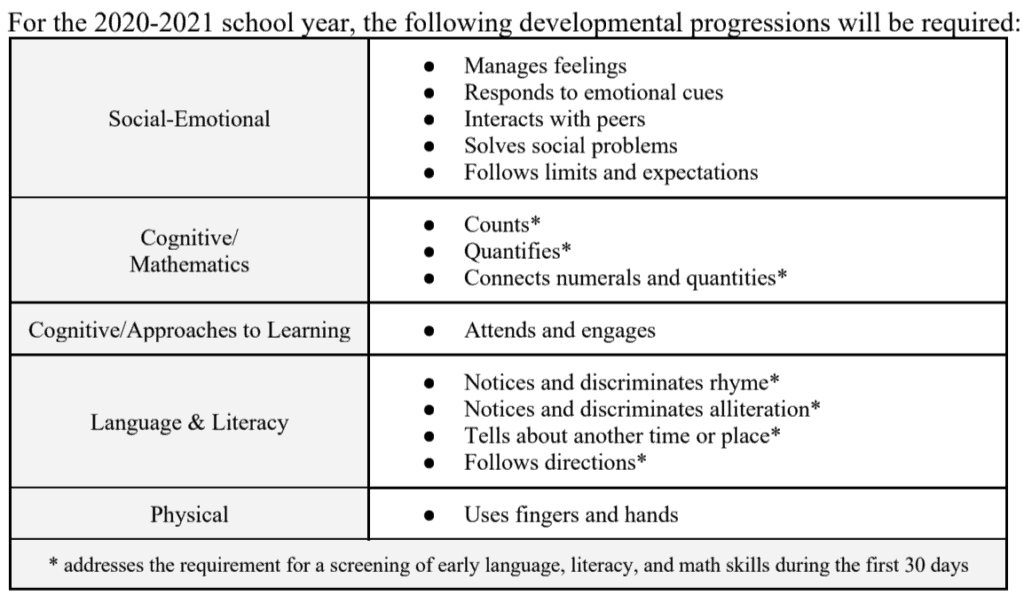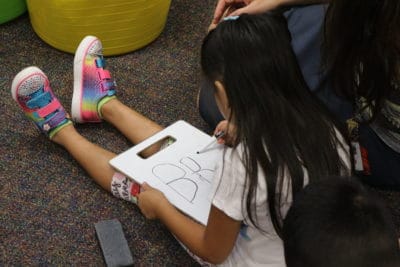

Assessments often get a bad rap. They can take away from valuable instruction time. And they can put pressure on educators and students that distracts them from learning.
But North Carolina is changing how a formative assessment called the NC Early Learning Inventory (NC ELI) — formerly the Kindergarten Entry Assessment (KEA) — will show up in kindergarten classrooms this fall, hoping to give teachers useful information about children at the start of a critical year in their academic journeys.
“For some children, it’s about helping to mitigate the lack of opportunities they had before entering kindergarten,” said Dan Tetreault, an Office of Early Learning region consultant. “For other children, it’s about maintaining that continuity from that high-quality pre-kindergarten program that they attended and to continue to support them. For other children, it’s about identifying that they need enrichment.”
Tetrault was the interim director of the office, which oversees early grades within the Department of Public Instruction, when the process of changing the assessment began.
A formative assessment like this one is designed to differ from the stress-inducing, high-stakes tests that teachers and students dread. Instead of being used to hold teachers or students accountable in the forms of pay or grades, formative assessments are meant to help teachers modify their strategies to fit students’ needs.
They can be effective tools to track students’ learning over time and to adjust instruction based on where students are. That’s especially important for kindergartners coming from a variety of settings, Tetreault said.
“There’s a lot of factors that go into where a child is developmentally and in their learning when they enter kindergarten,” he said. “The main goal of assessing children in this way … is to be able to identify where children are when they enter kindergarten so that teachers have a better understanding of where to start supporting that child.”
From collecting to instructional change
The former KEA, created in 2013 in response to a federal mandate and first used by teachers in 2015, has varied in its use and implementation, said Richard Lambert, a UNC-Charlotte educational leadership professor, who has worked with DPI to study how KEA is used in districts across the state. He said some variation is expected.
“An authentic formative assessment is something that [teachers] have to integrate more thoroughly into their total teaching process,” Lambert said. “It would necessarily involve implementation issues, no matter what the measure was.”
Some teachers who spoke with EducationNC in 2018 did not see how the assessment connected to other required assessments or to student learning long-term. Some did not see a connection between the assessment and their instruction. Lambert said his research has seen teachers become more comfortable with using the assessment and integrating it into their teaching process over the last year.
Feedback from teachers and administrators has spurred changes, Tetreault said.
“We’ve always approached this from this idea of consistently listening to the folks that are actually implementing and then making changes,” he said.
The new NC ELI, with a different name, platform, and additional resources for teachers, aims to help teachers get to know their students and tailor their instruction over the first 60 days of school and beyond. Kindergarten teachers use observation to make notes about children’s learning and development across several measures. At the end of 60 days, teachers use those notes to rate where students are on different progressions.
Dan Wuori, director of early learning at The Hunt Institute, an education policy organization, said these kinds of assessments — using teacher observation over time — reflect the best practices nationally. But these assessments take a lot of work and time, he said. Teachers need support to effectively translate the information into their teaching practice.
“That’s kind of the trick — is to provide along with these readiness assessments the kinds of professional development that teachers need to make sure that they are making the jump from just collecting the information to really using it,” Wuori said.
So what has changed?
The new assessment will be embedded within Teaching Strategies Gold, a national assessment platform that is widely used in early childhood and early elementary settings.
There are many more opportunities for teachers to monitor and think about students’ development with the new platform, Lambert said. The state requires that only the following 14 progressions be documented, but the platform has 60 total.


The progressions with asterisks should be the focus in the first 30 days of the year, according to the new State Board of Education policy.
The platform also provides examples for lessons and activities the teacher can use based on where students are on different progressions.
“The lesson planning tool allows teachers to identify small groups of children that are on the same skill level, and then it also has a library of teaching experiences, things they can incorporate into their lesson plans to help move students along those continuums of skills,” Tetreault said.
Although this assessment will give more information on more skills, and more resources on what to do with that information, Lambert said it’s important to remember that it’s difficult to individualize instruction.
“That’s just always one of the most challenging aspects of teaching,” Lambert said. “It’s a marker of really high-quality teaching often times. So what the assessment measure does is prepare them to do that, and gives them the information they need to do that better, and gets them reflecting and thinking about the differences between children and their needs. But it doesn’t really do the differentiating for them.”
The domain with the most required progressions to track is “social-emotional.” Tetreault attributed that to input from a pilot looking at data sharing between pre-K and kindergarten teachers.
Kindergarten teachers, he said, consistently said that children’s social and emotional development was key to success in their classrooms, and that they needed more information in that area.
Wuori, a former kindergarten teacher, sees this across the field.
“If you were to stop 20 people walking down the street and ask them, ‘What do you need to be ready to go to kindergarten?’ most people would skew toward, ‘You need to know letters and numbers,’” Wuori said. “But if you would ask kindergarten teachers, they would weigh in very heavily on the social-emotional domain.”
Lambert said another important aspect of Teaching Strategies Gold is something called interrater reliability — the likelihood that two people would rate the same child, or group of children, the same way. The platform provides access to an online course teachers can take that tests their ability to rate children appropriately.
“It gives a pretty good indication that they’re probably on the right track with implementing the assessment,” he said.
This test is not required for teachers, but Lambert said his team will pay attention to how much it could help.
Tetreault said the state has been getting information to districts already but will hold several train-the-trainer sessions, with the timing depending on COVID-19 guidelines. Districts will choose their team of trainers, who will receive a full day of training. Early education consultants will also be trained to support districts’ needs.
“What we believe to be true is that the learning curve for teachers won’t be as great as it was when we first rolled out the Kindergarten Entry Assessment,” Tetreault said.
Strengthening connection from pre-K to K
Experts say there is not a lot of communication between pre-K and kindergarten teachers or alignment between the two systems across the state.
Lambert said he once met an early educator in an NC Pre-K classroom who had created extensive portfolios in Teaching Strategies Gold for each of her students. Her classroom was in the elementary school that most of her kids would attend the next year.
“She said no kindergarten teacher ever asked her for the information, even though they were right down the hall, because they were required to use the KEA,” he said.
Teaching Strategies Gold is widely used across early childhood settings. It will allow for better transitions into kindergarten for students in formal pre-K settings, Tetreault said.
“There’s a lot of strength in the idea of kindergarten teachers … looking at a number of the same skill areas and being able to continue to provide support for children transitioning from those classrooms,” he said.
The platform is used in 90% of classrooms that receive funds from NC Pre-K, the state’s preschool for “at-risk” 4-year-olds who qualify based on family income and other factors such as special needs, parent military status, and English language ability.
In 2018, about 25% of 4-year-olds across the state attended NC Pre-K. Another quarter of them qualified but were not enrolled because of a lack of funding and other barriers to program expansion.
Through a $40 million 2019 Preschool Development Grant awarded to the state from the federal government, all NC Pre-K classrooms will receive professional development to ensure they use the platform. The grant also will ensure sharing among all programs using the platform, including 10,000 child-specific transition plans from a collaborative pilot between DPI and the Department of Health and Human Services.
Reporting out
Frequent visitors of the state’s school report cards might have noticed a new addition to the portfolio of information available about each elementary school — “incoming student readiness.”
Lambert said this measure was developed to give a general idea about where kindergarten students are, across a school population, when entering that school. The state used a group of experts and educators to develop developmental ranges with the former KEA — general expectations for where students should be with different skills.
This measurement is not connected to the schools’ performance grades or decisions about teacher or student performance. Lambert said that although this information is available as a general measurement for districts, entry assessments are more effective when used by teachers to learn about students’ specific needs. The readiness measure was developed in response to a legislative mandate, he said.
“It’s not really something that we would necessarily recommend to do,” Lambert said. “What’s more helpful for a teacher is not to know ‘ready or not.’ What’s helpful for a teacher is to know … where a child needs the most support and where a child is most advanced.”
The North Carolina Early Childhood Foundation has convened a data working group to research the best way for the state to measure and report on school readiness at the population level, with a report on its way sometime in April.
This reflects a national conversation about assessments — how they are created and how the information is used, Wuori said.
“It’s a challenge because one of the cardinal rules of assessment is really that assessment tools ought to be used for the purpose for which they are designed and have been validated,” Wuori said.
He said aggregating data from assessments to monitor where students are can help show policymakers where funding is needed.
“There is great value of having some sort of appropriate measure,” he said, “so that policymakers can look at whether things are trending in better or worse directions and can use that data really to speak to the need for continuing investment in (early childhood) programs.”
Editor’s Note: A previous version of this article incorrectly stated the number of development progressions on the assessment platform Teaching Strategies gold. The platform uses 60 progressions.




